
Brodick is the main village on the Isle of Arran, in the Firth of Clyde, Scotland. It is halfway along the east coast of the island, in Brodick Bay below Goat Fell, the tallest mountain on Arran. The name is derived from the Norse "breda-vick" meaning "Broad Bay".

The rowans or mountain-ashes are shrubs or trees in the genus Sorbus of the rose family, Rosaceae. They are native throughout the cool temperate regions of the Northern Hemisphere, with the highest species diversity in the Himalaya, southern Tibet and parts of western China, where numerous apomictic microspecies occur. The name rowan was originally applied to the species Sorbus aucuparia and is also used for other species in Sorbus subgenus Sorbus.
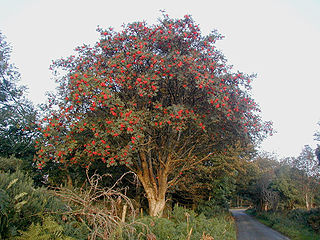
Sorbus aucuparia, commonly called rowan and mountain-ash, is a species of deciduous tree or shrub in the rose family. It is a highly variable species, and botanists have used different definitions of the species to include or exclude trees native to certain areas. A recent definition includes trees native to most of Europe and parts of Asia, as well as northern Africa. The range extends from Madeira, the British Isles and Iceland to Russia and northern China. Unlike many plants with similar distributions, it is not native to Japan.

Sorbus is a genus of over 100 species of trees and shrubs in the rose family, Rosaceae. Species of Sorbus (s.l.) are commonly known as whitebeam, rowan (mountain-ash) and service tree. The exact number of species is disputed depending on the circumscription of the genus, and also due to the number of apomictic microspecies, which some treat as distinct species, but others group in a smaller number of variable species. Recent treatments classify Sorbus in a narrower sense to include only the pinnate leaved species of subgenus Sorbus, raising several of the other subgenera to generic rank.
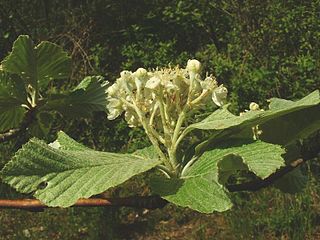
The whitebeams are members of the family Rosaceae, comprising subgenus Aria of genus Sorbus, and hybrids involving species of this subgenus and members of subgenera Sorbus, Torminaria and Chamaemespilus. They are deciduous trees with simple or lobed leaves, arranged alternately. They are related to the rowans, and many of the endemic restricted-range apomictic microspecies of whitebeam in Europe are thought to derive from hybrids between S. aria and the European rowan S. aucuparia; some are also thought to be hybrids with the wild service tree S. torminalis, notably the service tree of Fontainebleau Sorbus latifolia in French woodlands.

Catacol is a small village on the Isle of Arran, Scotland.

The tree species Sorbus americana is commonly known as the American mountain-ash. It is a deciduous perennial tree, native to eastern North America.
Sorbus pseudomeinichii, known as false rowan and Catacol whitebeam, is a rare tree endemic to the Isle of Arran in south west Scotland. It is believed to have arisen as a hybrid of the native rowan and the cut-leaved whitebeam which is in turn a rowan/Arran whitebeam hybrid. Until 2020 only two specimens of the Catacol whitebeam were known, at the time making it the rarest tree not only in Scotland, but joint rarest in the world with Wood's cycad, both with only one specimen living. A third was recorded as a sapling, but is believed to have been destroyed by deer. A seedling and grafted plants have also been grown in Edinburgh.
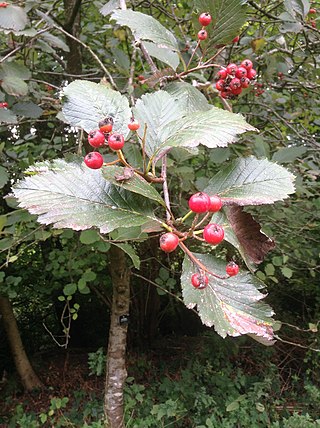
Sorbus anglica, the English whitebeam, is a species of whitebeam tree in the family Rosaceae. It is uncommonly found in Ireland and the United Kingdom, with an entire British population estimated at about 600 individuals.

Sorbus arranensis, sometimes referred to as the Scottish or Arran whitebeam is a species of plant in the family Rosaceae. It is endemic to the island of Arran in Scotland.
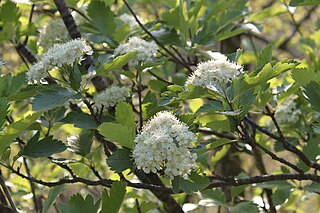
Sorbus leyana. Ley's whitebeam, is a species of small tree which is endemic to two sites in southern Wales. It is thought to have arisen by hybridisation of two species of Sorbus, one of which was the rowan. Its closest relatives are some of the other hybrid derived Sorbus species found in Britain.

Sorbus maderensis, a rowan, is a species of plant in the family Rosaceae. It is endemic to Madeira. It is threatened by habitat loss.
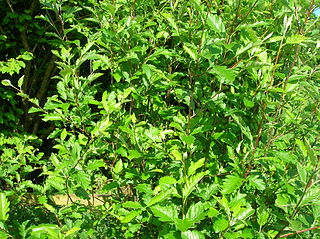
Sorbus pseudofennica is a species of plant in the family Rosaceae. Endemic to the Isle of Arran in Scotland, it is threatened by habitat loss. It is thought to be a naturally occurring hybrid between S. arranensis and S. aucuparia, probably with additional backcrossing with S. aucuparia. Sorbus arranensis is itself a hybrid between S. rupicola and S. aucuparia. Apomixis and hybridization are common in some groups of Sorbus species.

Sorbus × hybrida, the oakleaf mountain ash, Swedish service-tree or Finnish whitebeam, is a hybrid species of whitebeam native to Norway, eastern Sweden, southwestern Finland, and locally in Latvia.
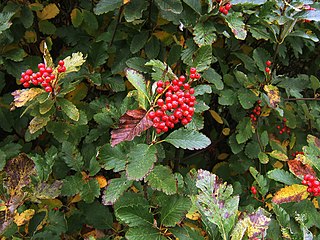
Sorbus mougeotii, the Vosges whitebeam or Mougeot's whitebeam, is a species of whitebeam native to the mountains of central and western Europe from the Pyrenees east through the Alps to Austria, and north to the Vosges Mountains.

The flora of Scotland is an assemblage of native plant species including over 1,600 vascular plants, more than 1,500 lichens and nearly 1,000 bryophytes. The total number of vascular species is low by world standards but lichens and bryophytes are abundant and the latter form a population of global importance. Various populations of rare fern exist, although the impact of 19th-century collectors threatened the existence of several species. The flora is generally typical of the north-west European part of the Palearctic realm and prominent features of the Scottish flora include boreal Caledonian forest, heather moorland and coastal machair. In addition to the native varieties of vascular plants there are numerous non-native introductions, now believed to make up some 43% of the species in the country.
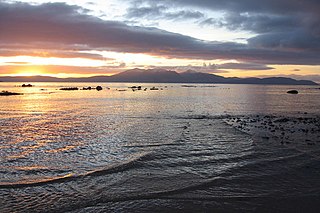
The Isle of Arran or simply Arran is an island off the west coast of Scotland. It is the largest island in the Firth of Clyde and the seventh-largest Scottish island, at 432 square kilometres (167 sq mi). Historically part of Buteshire, it is in the unitary council area of North Ayrshire. In the 2011 census it had a resident population of 4,629. Though culturally and physically similar to the Hebrides, it is separated from them by the Kintyre peninsula. Often referred to as "Scotland in Miniature", the island is divided into highland and lowland areas by the Highland Boundary Fault and has been described as a "geologist's paradise".

Sorbus californica, the California mountain ash, is an aggregate species of rowans native to western North America. The tree or bush is found in the mountains of California as the name suggests, but is not an ash, and this plant is sometimes cultivated. It has orange-red fruit and compound leaves that are toothed almost from base to apex, but is said to be most often confounded with the western North American species S. occidentalis which has pinkish fruit and leaflets with few teeth.

Scotland is ideal for tree growth, thanks to its mild winters, plentiful rainfall, fertile soil and hill-sheltered topography. As of 2019 about 18.5% of the country was wooded. Although this figure is well below the European Union (EU) average of 43%, it represents a significant increase compared to the figure of 100 years previously: in 1919 it was estimated that only 5% of the country's total land area was covered in forest. The Scottish Government's Draft Climate Change Plan has set an aim of increasing coverage to 21% of Scotland by 2032, with the rate of afforestation rising to 15,000 hectares per year by 2024.




















